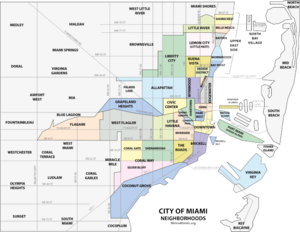Coral Way
| Coral Way | |
|---|---|
| Neighborhood of Miami | |

Part of the scenic Coral Way road within the Coral Way neighborhood of Miami.
|
|
 Coral Way neighborhood within the City of Miami |
|
| Coordinates: 25°45′N 80°17′W / 25.750°N 80.283°W | |
| Country | United States |
| State | Florida |
| County | Miami-Dade County |
| City | Miami |
| Subdistricts of Coral Way |
Neighborhoods list
|
| Government | |
| • City of Miami Commissioner | Frank Carollo, Francis Suárez, and Marc D. Sarnoff |
| • Miami-Dade Commissioners | Carlos A. Giménez, Bruno Barreiro, and Rebeca Sosa |
| • House of Representatives | Carlos Lopez-Cantera (R) and Luis García, Jr. (R) |
| • State Senate | Miguel Díaz de la Portilla (R) |
| • U.S. House | Ileana Ros-Lehtinen (R) |
| Population (2010) | |
| • Total | 35,062 |
| • Density | 11,645/sq mi (4,496/km2) |
| Time zone | EST (UTC-05) |
| ZIP Code | 33129, 33133, 33135, 33145 |
| Area code(s) | 305, 786 |
| Website | Coral Way neighborhood |
Coral Way is a neighborhood within Miami, Florida that is defined by Coral Way, a road established by Coral Gables founder George E. Merrick during the 1920s. It is located in Miami-Dade County, Florida, United States.
The Coral Way neighborhood is served by the Miami Metrorail at Vizcaya (South Dixie Highway/US 1 and West First Avenue) and Coconut Grove stations (US 1 and West 27th Avenue/SR 9).
The Architecture in the Coral Way neighborhoods reflects the early-20th Century. Some of the oldest sections contain a mixture of Mission Revival Style architecture and Bungalow homes of the 1920s, along with the Art Deco style from the 1930s and the modest post-World War II dwellings.
The Coral Way area is best known for its historic urban boulevard along SW 22nd Street (Coral Way). One of the main thoroughfares between Coral Gables and the City of Miami, Coral Way passes through the City of Miami between SW 37th Avenue and Brickell Avenue. The Coral Way Corridor began in 1922 with citrus lined streets; later growing to have streetcar tracks down the center of the road, connecting Downtown Miami to Coral Gables. In 1929, a Roadside Beautification Program was started, and 1200 Banyan trees were planted along the median of the boulevard. Today, Coral Way remains one of the most beautiful corridors in South Florida.
...
Wikipedia
